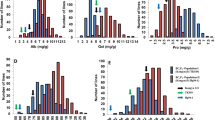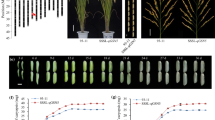Abstract
Protein content (PC) in rice endosperm plays an important role in determining rice grain quality. However, the genetic mechanism underlying grain PC remains unclear. In order to better understand the genetic basis of this trait, a chromosome segment substitution line (CSSL) population derived from the cross of Sasanishiki/Habataki was employed for genetic analysis and gene mapping. In three environments, seven quantitative trait loci in total were identified, of which only qPC-1 was repeatedly detected across three environments, and qPC-10 was identified in two environments; the other five QTLs were detected in one environment. In order to fine-map qPC-1, a CSSL with low PC, SL402, harboring qPC-1, was crossed with Sasanishiki to develop F2 and F3 segregation populations. qPC-1 was finally delimited to a 41-kb DNA region on chromosome 1. Storage protein component analysis indicated that the allele from Habataki on qPC-1 can significantly decrease the glutelin content, consequently leading to the decrease in PC. These results provide an important aid for map-based cloning of qPC-1, and the markers linked to qPC-1 could be applied to rice quality improvement.



Similar content being viewed by others
References
Aluko G, Martinez C, Tohme J, Castano C, Bergman C, Oard JH (2004) QTL mapping of grain quality traits from the interspecific cross Oryza sativa × O. glaberrima. Theor Appl Genet 109:630–639
Hu ZL, Li P, Zhou MQ, Zhang ZH, Wang LX, Zhu LH, Zhu LG (2004) Mapping of quantitative trait loci (QTLs) for rice protein and fat content using doubled haploid lines. Euphytica 135:47–54
Iida S, Amano E, Nishio T (1993) A rice (Oryza sativa L.) mutant having a low content of glutelin and a high content of prolamine. Theor Appl Genet 87(3):374–378
Iida S, Kusaba M, Nishio T (1997) Mutants lacking glutelin subunits in rice: mapping and combination of mutated glutelin genes. Theor Appl Genet 94(2):177–183
Juliano BO (1985) Rice chemistry and technology, 2nd edn. American Association of Cereal Chemists, Incorporated, Saint Paul
Kumamura T, Satoh H, Iwata N, Ogawa M, Tanaka K (1988) Mutants for rice storage proteins: 1. Screening of mutants for rice storage proteins of protein bodies in the starchy endosperm. Theor Appl Genet 76:11–16
Kusaba M, Miyahara K, Iida S, Fukuoka H, Takano T, Sassa H, Nishimura M, Nishio T (2003) Low glutelin content1: a dominant mutant that suppress the glutelin multigene family via RNA silencing in rice. Plant Cell 15:1455–1467
Li JM, Xiao JH, Grandillo S, Jiang LY, Wan YZ, Deng QY, Yuan LP, McCouch S (2004) QTL detection for rice grain quality traits using an interspecific backcross population derived from cultivated Asian (O. sativa L.) and African (O. glaberrima S.) rice. Genome 47(4):697–704
Li C, Pan DJ, Sun CQ, Zhou HQ, Fan ZL, Chen JY, Wang XK (2006) QTL location of high protein gene in rice grain. J Plant Genet Res 7(2):170–174
Lin R, Luo Y, Liu D, Huang C (1993) Determination and analysis on principal qualitative characters of rice germplasm. In: Ying C (ed) Rice germplasm resources in China. Agricultural Science and Technology Publisher of China, Beijing, pp 83–93
Liu XL, Wan XY, Ma XD, Wan JM (2011) Dissecting the genetic basis for the effect of rice chalkiness, amylose content, protein content, and rapid viscosity analyzer profile characteristics on the eating quality of cooked rice using the chromosome segment substitution line population across eight environments. Genome 54(1):64–80
Martin M, Fitzgerald MA (2002) Proteins in rice grain influence cooking properties. J Cereal Sci 36:285–294
McCouch SR (2008) CGSNL (Committee on Gene Symbolization, Nomenclature and Linkage, Rice Genetics Cooperative) gene nomenclature system for rice. Rice 1:72–84
Nadeau JH, Singer JB, Matin A, Lander ES (2000) Analyzing complex genetic traits with chromosome substitution strains. Nat Genet 24:221–225
Nakamura Y (2002) Towards a better understanding of the metabolic system for amylopectin biosynthesis in plants: rice endosperm as a model tissue. Plant Cell Physiol 43(7):718–725
Peng B, Kong HL, Li YB, Wang LQ, Zhong M, Sun L, Gao GJ, Zhang QL, Luo LJ, Wang GW, Xie WB, Chen JX, Yao W, Peng Y, Lei L, Lian XM, Xiao JH, Xu CG, Li XH, He YQ (2014) OsAAP6 functions as an important regulator of grain protein content and nutritional quality in rice. Nat Commun 5:4847. doi:10.1038/ncomms5847
Rogers SO, Bendch AJ (1988) Extraction of DNA from plant tissues. Plant Mol Biol Man 6:1–10
Tan YF, Li JX, Yu SB, Xing YZ, Xu CG, Zhang QF (1999) The three important traits for cooking and eating quality of rice grains are controlled by a single locus in an elite rice hybrid, Shanyou 63. Theor Appl Genet 99:642–648
Tan YF, Sun M, Xing YZ, Hua JP, Sun XL, Zhang QF, Corke H (2001) Mapping quantitative trait loci for milling quality, protein content and color characteristics of rice using a recombinant inbred line population derived from an elite rice hybrid. Theor Appl Genet 103:1037–1045
Tian R, Jiang GH, Shen LH, Wang LQ, He YQ (2005) Mapping quantitative trait loci underlying the cooking and eating quality of rice using a DH population. Mol Breed 15:117–124
Tian ZX, Qian Q, Liu QQ, Yan MX, Liu XF, Yan CJ, Liu GF, Gao ZY, Tang SZ, Zeng DL, Wang YH, Yu JM, Gu MH, Li JY (2009) Allelic diversities in rice starch biosynthesis lead to a diverse array of rice eating and cooking qualities. Proc Natl Acad Sci USA 106(51):21760–21765
Unnevehr LJ, Duff B, Juliano BO (1992) Consumer demand for rice grain quality. International Rice Research Institute, Manila
Wang LQ, Liu WJ, Xu Y, He YQ, Luo LJ, Xing YZ, Xu CG, Zhang QF (2007) Genetic basis of 17 traits and viscosity parameters characterizing the eating and cooking quality of rice grain. Theor Appl Genet 115:463–476
Wang LQ, Zhong M, Li XH, Yuan DJ, Xu YB, Liu HF, He YQ, Luo LJ, Zhang QF (2008) The QTL controlling amino acid content in grain of rice (Oryza sativa) were co-localized with the regions involved in amino acid metabolism pathway. Mol Breed 21(1):127–137
Weng JF, Wan XY, Wu XJ, Wang HL, Qu HQ, Wan J (2006) Stable expression of QTL for AC and PC of milled rice (Oryza sativa L.) using a CSSL population. Acta Agron Sin 32(1):14–19
Yan CJ, Tian ZX, Fang YW, Yang YC, Li J, Zeng SY, Gu SL, Xu CW, Tang SZ, Gu MH (2011) Genetic analysis of starch paste viscosity parameters in glutinous rice (Oryza sativa L.). Theor Appl Genet 122:63–76
Ye GY, Liang SS, Wan JM (2010) QTL mapping of protein content in rice using single chromosome segment substitution lines. Theor Appl Genet 121:741–750
Yoshida S, Ikegami M, Kuze J, Sawada K, Hashimoto Z, Ishii T, Nakamura C, Kamijima O (2002) QTL analysis for plant and grain characters of sake-brewing rice using a doubled haploid population. Breed Sci 52:309–317
Zheng LN, Zhang WW, Chen XG, Ma J, Chen WW, Zhao ZG, Zhai HQ, Wan JM (2011) Dynamic QTL analysis of rice protein content and protein index using recombinant inbred lines. J Plant Biol 54:321–328
Acknowledgments
We thank the Rice Genome Project of the National Institute of Agrobiological Sciences of Japan for kindly providing the CSSL population. This study was supported financially by the National Natural Science Foundation (31371233), the Natural Science Foundation of Jiangsu Province (BK2012684, 14KJA210002), the project of Six Talent Peaks in Jiangsu Province (2012-NY-027), the research and innovation program of postgraduate in Jiangsu province (CXLX13_914), and a project funded by the Priority Academic Program Development of Jiangsu Higher Education Institutions.
Conflict of interest
The authors declare that they have no conflict of interest.
Author information
Authors and Affiliations
Corresponding author
Additional information
Yihao Yang and Min Guo have equally contributed equally to this work.
Electronic supplementary material
Below is the link to the electronic supplementary material.
Rights and permissions
About this article
Cite this article
Yang, Y., Guo, M., Li, R. et al. Identification of quantitative trait loci responsible for rice grain protein content using chromosome segment substitution lines and fine mapping of qPC-1 in rice (Oryza sativa L.). Mol Breeding 35, 130 (2015). https://doi.org/10.1007/s11032-015-0328-z
Received:
Accepted:
Published:
DOI: https://doi.org/10.1007/s11032-015-0328-z




